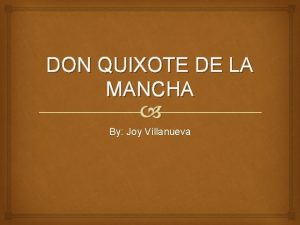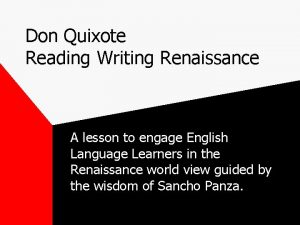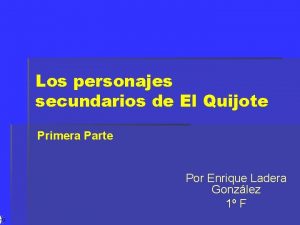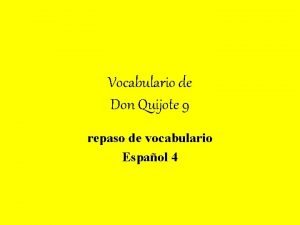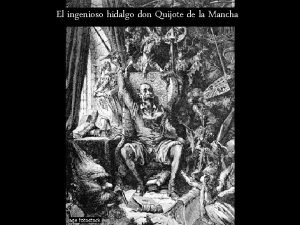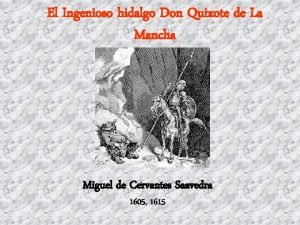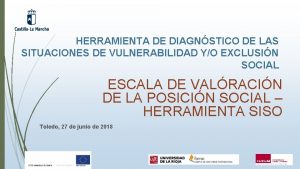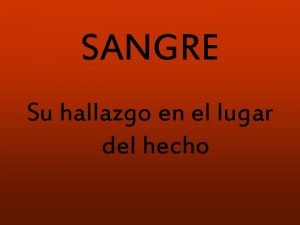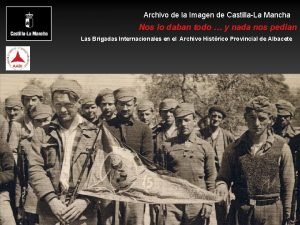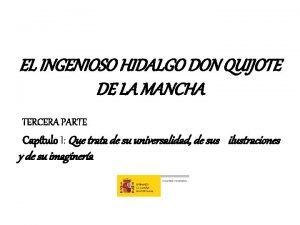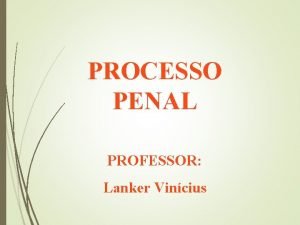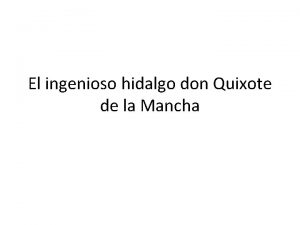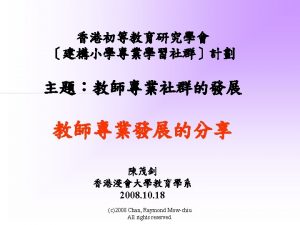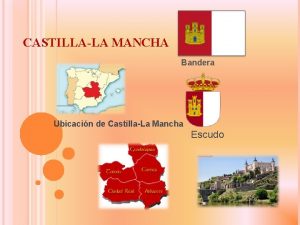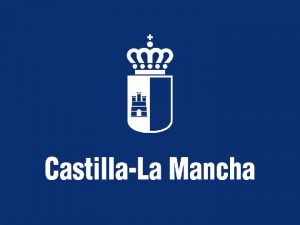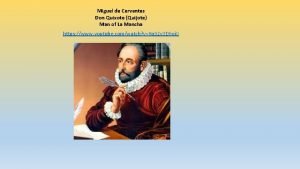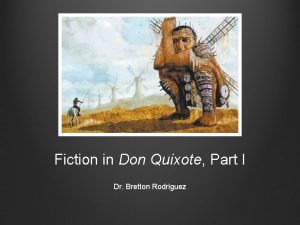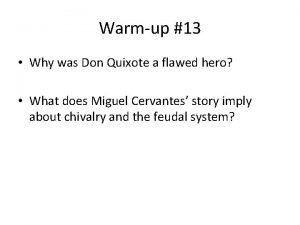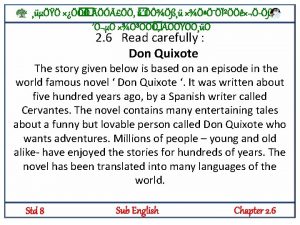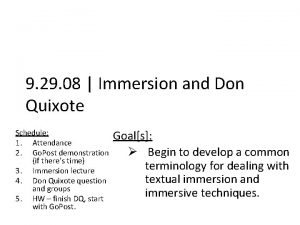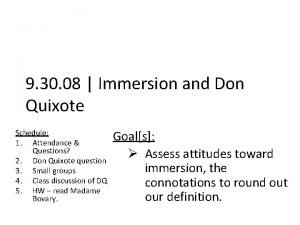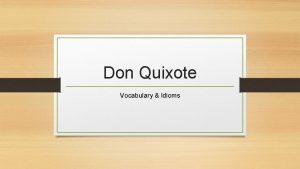DON QUIXOTE FROM LA MANCHA INSERVICE TEACHER TRAINING
































- Slides: 32

DON QUIXOTE FROM LA MANCHA IN-SERVICE TEACHER TRAINING CENTER IN TOMELLOSO. LA MANCHA. SPAIN

• CERVANTES DIGITAL LIBRARY • FACSIMILE EDITION. 1605 • ENGLISH VERSION FROM DE NOVEL • CERVANTES WORKS • DON QUIJOTE DE LA MANCHA. SPANISH VERSION. • DON QUIXOTE, ENGLISH-SPANISH DICTIONARY

• CERVANTES, DON QUIXOTE AND HIS TIME. • CASTILLA LA MANCHA, A LAND NOT ONLY IN THE IMAGINATION, A REAL LAND


TITLE PAGE OF THE FIRST EDITION OF DON QUIXOTE, 1605

THE BEST LITERARY WORKS OF ALL TIME In 2002 the Norwegian Book Club and the Nobel Foundation organised a survey of the best work of fiction ever… A selection of 100 writers from 54 countries chose Don Quixote as the winner; in the second place Gustave Flaubert’s Madame Bovary (who came runner-up). Each of the 100 writers, (several who have won a Nobel Prize), had to mention 10 book titles to help create a Library of Universal Literature. Cervantes won Flaubert by 50% more votes. PICASSO: DON QUIXOTE

WORLD BOOK DAY Miguel de Cervantes, author of Don Quixote, died on the 23 rd of April, 1616. On that very same day of the same year, William Shakespeare also died. The UNESCO declared the 23 rd of April as the WORLD BOOK DAY by request of the Spanish government since their national book day had been celebrated on that day for many years. On that day, almost every Spaniard buys a book for their loved one. In some regions of Spain, such as Catalonia, the book is accompanied with a rose. CERVANTES by FRANCISCO DE GOYA

THE FIRST TRANSLATION WAS INTO ENGLISH In 1612, the first translation of Don Quixote into a foreign language appears 4 years before the death of Cervantes and 7 years after the original edition (1605). The person responsible for that translation, titled The History of the Valorous and Wittie Knight-Errant, Don Quixote of the Mancha, was an Englishman named Thomas Shelton. THE COVER OF THE FIRST ENGLISH EDITION OF DON QUIJOTE

THE MOST TRANSLATED BOOK AFTER THE BIBLE

IT HAS BEEN THE INSPIRATION FOR ARTISTS WORLDWIDE: LITERATURE, FILMS, MUSICAL COMPOSITIONS, PLAYS, BALLETS, PAINTINGS. . .

AMONGST MANY OTHER THINGS. . .

ALL OVER THE WORLD…

IT HAS GIVEN A UNIQUE PERSONALITY TO THE SPANISH WITH ITS VERY OWN WORD quijote 2. m. A steadfastly man in defence of causes that he considers just, without achieving his purpose. Royal Spanish Language Academy DICTIONARY DON QUIXOTE by DALÍ

MIGUEL DE CERVANTES (1547 -1616): A LIFE FULL OF ADVENTURE

We don’t know exactly when he was born but we do know that he was born in Alcalá de Henares, near Madrid and that he was baptized on the 9 th of October, 1547. Nor do we know about his childhood. Maybe he studied in a school in Valladolid and in Seville. It’s possible that he left his studies to do military service in Flandes. Around 1569 he joined the army and was posted to Italy. He took part in the Naval Battle of Lepanto. There, he was shot three times and because of that he lost the use of his left hand was therefore known as “the cripple of Lepanto”. PORTRAIT OF CERVANTES (1738)

In September of 1575, when Cervantes was travelling towards Spain he was carrying with him some letters from illustrious Spanish figures. His boat was attacked by Algerian troops and Cervantes was put in jail. They thought he could be someone with a very high social status (because of the letters) so they held him for ransom. Finally, Cervantes was freed after 5 years in prison. On arriving in Spain, Cervantes didn’t have any money or work so he decided to join the army again. He took part in the fight for the Azore Islands, which was a Portuguese territory in the middle of the Atlantic. It is more than likely that, while he was there, he wrote “La Galatea” and maybe the first part of “Persiles y Segismunda”. PORTRAIT OF CERVANTES (1791)

Since he was crippled, Miguel didn’t expect a promotion in the army so he tried his luck at literature and published La Galatea in 1585. He achieved some fame but not a lot of money. Cervantes married Catalina Palacios Salazar y Vozmediano, a woman who was 18 years younger than him. Poverty forced Cervantes to look for work. In 1588 he was put in charge of buying supplies for the Spanish Armada. He had some trouble with the job and was jailed at least twice. These events confirm the legend that Don Quixote was written while Cervantes was in prison. PORTRAIT OF CERVANTES (1819)

When his father died, he had to take care of his two sisters, his niece and their maid as well as his own wife and daughter. He was an only man amongst many women. His sisters didn’t have a very good reputation and it was rumoured that they had male visits at all hours “both night and day”. Cervantes learnt to respect feminine freedom in the bosom of his own family (this is reflected in Don Quixote where the woman is seen as a very respectful and modern figure for that time). PORTRAIT OF CERVANTES (1859)

In May of 1590, he asked the King to grant him a place in the West Indies. He didn’t have better luck in literature. Cervantes was already 50 years old when he wrote Don Quixote (which is considered the first modern novel). After writing that book, Cervantes became famous overnight but his economic problems continued. In 1605 he was accused of being in a knife fight and he and his family were jailed for over a week. Since nobody knew where he was during that time, it was said that the writer lived a secluded life for the following three years. PORTRAIT OF CERVANTES (1841)

From 1609 until 1616 (the year that he died) Cervantes lived in Madrid. The last years of his life were filled with intense literary activity. He published his 12 exemplary novels along with his satirical poem Viaje del Parnaso. Not many years later, the publication of the copy written by Alonso Fernández de Avellaneda appeared (a sequel that didn’t have anything to do with Cervantes’ concept), and this spurred Cervantes on to completing the second part of Don Quixote , which was published 1615. Cervantes died on the 23 rd of April, 1616. PORTRAIT OF CERVANTES (1900)

CERVANTES’ SPAIN

Cervantes’ Spain had approximately 6, 500, 000 inhabitants. It was a society in profound crisis but at the same time its was a timely moment for the development of all types of arts. Indeed, the crisis in Spain begins to show. The aristocracy becomes poor but it is mainly the more modest social classes that suffer the most. As a result of that, beggars and vagabonds etc. begin to emerge. BARCELONA IN 1572

Internal politics was disastrous because the governors only sought economic benefit for themselves. As for the economy, Spain (which imported large quantities of gold and silver, extracted from South America), had to produce all its coins in copper because the gold and silver was used to pay off debts. . . The capital moved to the city of Valladolid: Philip III’s court was always full of parties, bullfights and similar entertainment…, forgetting about the country’s problems. VALLADOLID IN 1572

The Moors (people of Arabian origin but baptized as Christians) were expelled from the country: between 150300, 000 people. This caused a steep decline in agriculture because the majority of the Moors were farm workers. TOLEDO IN 1598

During this social, demographical, political and economic crisis, some of the best names in Spanish art emerged, in an era known as The Golden age: in literature Lope de Vega, Tirso de Molina or Quevedo; in painting El Greco, Velázquez, Zurbarán or Ribera; or VELÁZQUEZ: LAS MENINAS even in architecture, such as The Palace of the Escorial, close to Madrid. PALACE OF EL ESCORIAL, BY JUAN DE HERRERA


PLOT Alonso Quijano (Don Quixote) goes crazy from reading too many books of chivalry. This madness makes him try to imitate the adventures which he has read: he leaves his hometown, he embarks in a series of adventures and he returns defeated.

FIRST PART(1605) FIRST JOURNEY Don Quixote prepares his old, rusty weapons which belonged to his greatgrandfathers. He puts them on and sets out through La Mancha with the hope of doing justice, just as it happened in the stories he read. He arrives at an inn which he believes is a castle, he is knighted in a ridiculous ceremony, he seeks adventures and returns home wounded.

The SECOND JOURNEY (also in the first book) makes up the rest of the book. Don Quixote escapes from his house again, but this time he is accompanied by a humble neighbour who acts as his squire. The appearance of Sancho Panza enriches the possibilities of the novel since Sancho Panza is going to be Quixote’s confident, opening the doors to a dialogue which will be of great importance. Besides, they are two opposite characters well matched. On this journey, we can read about a lot of different adventures and how Don Quixote was tricked into going home.

SECOND PART (1615) It covers the third and last journey. New adventures on the way to Barcelona. Most of them take place in the court of some Dukes that have read the first part of the book, they know of Don Quixote and for a bit of entertainment they pretend that they live in a chivalrous court. At the end of the second part, another character from Don Quixote’s village, dressed also as a knight-errant, challenges Don Quixote and wins. This forces Don Quixote to go back home. There, he regains his sanity and dies.

MEANING Don Quixote is the model of the ideal aesthetic and ethical life. He becomes a knight-errant so that he can defend justice in the world and from the beginning he wants to be a literary character. In short, he wants to do good and live the life as if it were a work of art. Don Quixote is a synthesis of life and literature, a life that has been lived and a life that has been dreamed. A fabulous integration of reality and fantasy. An extraordinary example of the difficulties of writing about complex human relationships.

CURIOSITIES A copy of Don Quixote in 1605, cost around 290 maravedies (the currency at that time), which was about 4 euros today. Recently Sotheby’s in New York, auctioned a copy of the first edition from 1605 and was sold for $6, 000. Don Quixote had immediate success: a couple of weeks after the first publication, three false copies appeared in Lisbon.
 Don quixote marmolada
Don quixote marmolada Don quixote
Don quixote Don quixote 2000
Don quixote 2000 Don quixote renaissance
Don quixote renaissance Honore daumier don kichot
Honore daumier don kichot Https://www.youtube-nocookie. com/embed/xu7fdd1sphc?rel=0
Https://www.youtube-nocookie. com/embed/xu7fdd1sphc?rel=0 Inservice training assignment
Inservice training assignment Personajes secundarios del quijote
Personajes secundarios del quijote Argumentos de la obra don quijote dela mancha
Argumentos de la obra don quijote dela mancha Descripcion fisica don quijote
Descripcion fisica don quijote Vocabulario don quijote
Vocabulario don quijote Obras literarias
Obras literarias Vocabulario de don quijote dela mancha por capítulos
Vocabulario de don quijote dela mancha por capítulos Estructura interna de don quijote dela mancha
Estructura interna de don quijote dela mancha Quijote animal
Quijote animal Inservice
Inservice Inservice examples
Inservice examples Herramienta siso castilla la mancha
Herramienta siso castilla la mancha Taponamiento anterior
Taponamiento anterior Prueba de takayama
Prueba de takayama Archivo de la imagen de castilla la mancha
Archivo de la imagen de castilla la mancha Signo de schwartze
Signo de schwartze Mancha de asfalto
Mancha de asfalto Mancha
Mancha Teoria da mancha purgada
Teoria da mancha purgada Valores en el quijote de la mancha
Valores en el quijote de la mancha To take something that doesn't belong to you
To take something that doesn't belong to you Sample erf
Sample erf Good afternoon teacher.
Good afternoon teacher. Viikki teacher training school
Viikki teacher training school Igcse teacher training
Igcse teacher training Fsaa modules
Fsaa modules Montessori early learning foundation
Montessori early learning foundation


